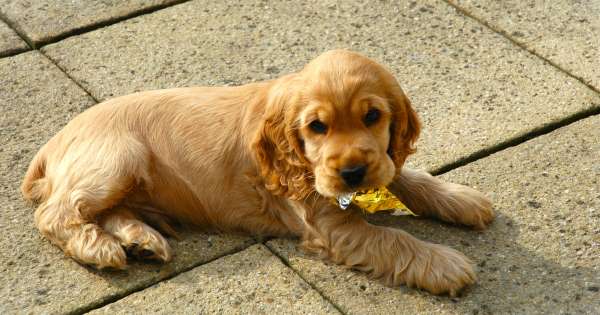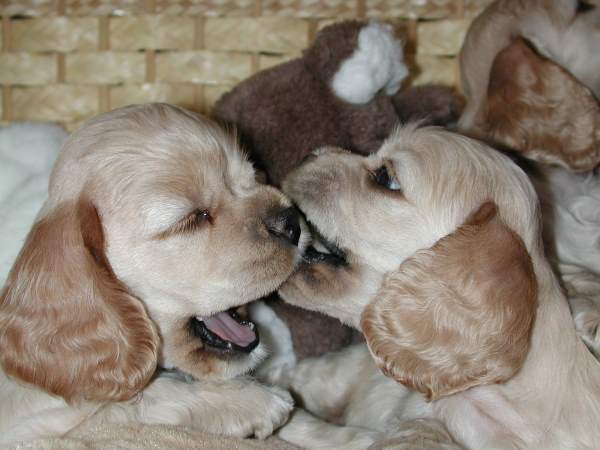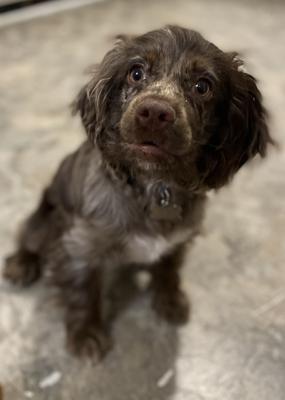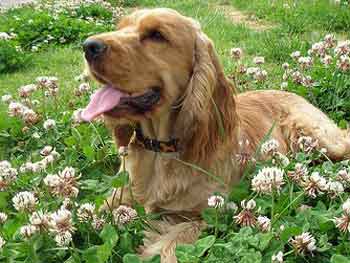- Home
- Cocker Spaniel Puppy Care
- How To Brush Puppy Teeth
How To Brush Puppy Teeth
This article on how to brush puppy teeth will help you keep those sharp little gnashers in tip-top condition!
If your puppy is used to the feel of your fingers or a toothbrush inside his mouth at this young age, you won't have any problems brushing his teeth when he's older.
Brushing puppy teeth regularly will help keep his teeth clean, healthy and plaque-free, so if you want to avoid your puppy having dental disease and expensive treatment costs, read on!
Teach Your Puppy To Enjoy Having His Teeth Brushed!
Your puppy now has his little razor-sharp teeth, and although they may be pristine now, they won't be for long.
While little puppy teeth may not need cleaning, adult canine teeth need a dental care routine to keep them sparkling and healthy.
The trick is to get your puppy used to the feel of your fingers (and later, a toothbrush) in his mouth now; while he's still young, it will be plain sailing.
If you don't, you'll likely have problems brushing his teeth when he's an adult Cocker.
However, it's not the end of the world if you didn't manage to do this or you've adopted an adult dog whose teeth have never seen a toothbrush. You can still acclimatize your Cocker to having his teeth brushed, although it may take a little longer.
How To Brush Puppy Teeth
When brushing your puppy's teeth for the first time, it's better to begin using your fingers; don't use a toothbrush just yet.
Here's how to brush your puppy's teeth:
- Begin by stroking the outside of your puppy's face; your fingers won't be going inside his mouth just yet.
Gently and slowly, massage his cheeks in a circular motion where the teeth meet the gums. Talk to and praise him while you do this, but avoid making too much fuss.
Practice every day, and when you reach the point where your puppy is more than happy with this massaging motion, you can move on to the next step. - Put a little squeeze of doggie toothpaste or peanut butter, specially formulated for dogs, onto your fingertip and let your puppy lick it off. Your puppy will enjoy the taste of these, especially the peanut butter, and will view them as a treat.
Many kinds of pet toothpaste taste like chicken or liver, so I don't think you'll have any problem there! - Your next step is to lift your puppy's top lip, put your finger (with a little squeeze of toothpaste) into his mouth, and gently massage his gums and delicate puppy teeth for 10 seconds, gradually working up to 30 seconds.
Puppies' teeth are sharp, so take care. If your puppy doesn't object, praise him.
You may find your Cocker Spaniel is too intent on licking the toothpaste from your fingers, stopping you from massaging his gums.
If that's the case, gently hold his muzzle closed with one hand and gently lift his top lip with the other. Then you can massage his top teeth and gums before moving on to the bottom gum line.
Don't worry about your puppy's front teeth at this stage, as they pretty much look after themselves.
Introduce Your Puppy To His Toothbrush
When you believe he's ready, introduce your Cocker to his new puppy toothbrush (which should be the softest you can buy). Don't use a human toothbrush; you could use a baby toothbrush at a push.
- Place a small amount of toothpaste onto the brush and work it downwards into the bristles. Doing this will help stop your puppy from licking the toothpaste off the brush and increase the chances of the toothpaste actually reaching your dog's teeth!
Let him lick and nibble the toothbrush before putting it into his mouth so that he can feel the bristles with his teeth and his tongue. Don't brush any of his teeth at this stage. - At your next session, gently brush two or three puppy teeth for 10 or 20 seconds, then stop and give your pup lots of praise. Remember, don't overdo the praise; your puppy may become too excited, and you'll get nowhere.
Don't go any further if you think your puppy is becoming agitated; better still if you can anticipate his anxiety and stop before he becomes anxious. This way, you will avoid your puppy learning that if he objects, you will cease.
Using A Finger Brush To Brush Puppy Teeth
If you prefer not to put your bare fingers into your puppy's mouth, you can buy a finger brush, a ribbed, rubber sleeve that fits onto your finger. A finger brush can be just as effective as a toothbrush and will help your puppy get used to feeling your fingers in his mouth; it will also help to minimize the pain his biting your fingers causes!
How To Brush Puppy Teeth For Best Results!
Keep your puppy's new experience with his toothbrush as positive as possible. When you've finished, and he's responded well, you can heap on the praise and give him a small treat.
Your aim here is to teach your puppy to associate positive experiences when your fingers or toothbrush are near or inside his mouth.
Over the next few sessions, gradually increase the number of puppy teeth brushed until your brushing routine follows the steps outlined in brushing your dog's teeth for best results.
Good luck!
Points To Note When Brushing Puppy Teeth
Add Brushing Your Puppy's Teeth Into His Grooming Routine
Now that you've learned how to brush puppy teeth, you'll soon get into the swing of things and be able to incorporate it into your puppy's grooming routine. If you don't have the time to brush his teeth daily, two to three times weekly will be fine.
Teach Your Puppy Not To Bite
If your puppy is biting, his little sharp teeth will hurt, and you may want to skip brushing puppy teeth for now. You must teach your puppy that biting and chewing fingers is not allowed, it's called bite inhibition, and I highly recommend it!
Examine Your Puppy's Mouth and Teeth For Signs of Dental Problems
It's always a good idea to take notice of your dog's mouth and teeth as you're cleaning them; your puppy's oral hygiene is important.
Check for signs of dental or gum disease to stay on top of your puppy's oral health. Look for the following signs that your puppy may have oral hygiene or dental problems:
- Foul smelling breath,
- Damaged, red or inflamed gums
- Bleeding gums,
- Loose teeth,
- Discoloured teeth,
- Drooling (more than normal!),
- Plaque and tartar,
- Difficulty in crunching kibble,
- Your puppy is pawing at his mouth.
If your puppy is showing any of these symptoms, I recommend you contact your vet.
Taking care of your puppy's oral hygiene not only ensures his teeth are cared for, his breath will be smelling fresh and puppy-like; there's nothing nicer than puppy breath!
Photo credits for How To Brush Puppy Teeth:
1. Website owners photo







